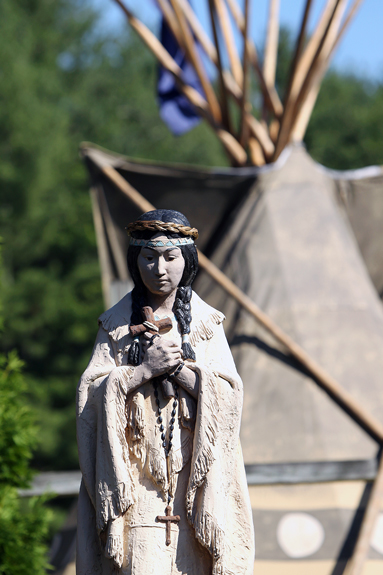by Carol Glatz

VATICAN CITY (CNS) – Pope Benedict XVI advanced the sainthood causes of Blessed Marianne Cope of Molokai and Blessed Kateri Tekakwitha, both of whom have ties to New York State.
He also formally recognized the martyrdom of 64 victims of the Spanish Civil War and advanced the causes of 18 other men and women.
During a meeting Dec. 19 with Cardinal Angelo Amato, prefect of the Congregation for Saints’ Causes, the pope signed the decrees recognizing the miracles needed for the canonizations of Blesseds Marianne and Kateri.
Before a date is set for the canonization ceremonies, there must be an “ordinary public consistory,” a formal ceremony opened and closed with prayer, during which cardinals present in Rome express their support for the pope’s decision to create new saints.
Blessed Marianne, who worked as a teacher and hospital administrator in New York, spent the last 30 years of her life ministering on the Hawaiian island of Molokai to those with leprosy. She died on the island in 1918 at age 80 and was beatified in St. Peter’s Basilica in 2005.
Blessed Kateri, known as the Lily of the Mohawks, was born to a Christian Algonquin mother and a Mohawk father in 1656 in upstate New York along the Hudson River. She was baptized by a Jesuit missionary in 1676 when she was 20, and she died in Canada four years later. In June, 1980, she became the first Native American to be beatified.
Pope Benedict also recognized miracles attributed to the intercession of five other people, who now can be declared saints. They are:
• Blessed Giovanni Battista Piamarta, an Italian priest who founded the Congregation of the Holy Family of Nazareth for men and the Humble Servants of the Lord for women. He died in 1913.
• Blessed Jacques Berthieu, a French Jesuit priest who was martyred in Madagascar in 1896.
• Blessed Carmen Salles y Barangueras, the Spanish founder of the Sisters of the Immaculate Conception. She worked with disadvantaged girls and prostitutes and saw that early education was essential for helping young women. She died in 1911.
• Blessed Peter Calungsod, a lay Catholic from Cebu, Philippines, who accompanied Jesuit missionaries to Guam as a catechist and was martyred there in 1672 while he was in his late teens.
• Blessed Anna Schaffer, a lay German woman who wanted to be a missionary, but couldn’t do so after a succession of physical accidents and disease. She accepted her infirmity as a way of sanctification. Her grave has been a pilgrimage site since her death in 1925.
Blessed Kateri Tekakwitha, is the young Indian maiden who, despite objections from some in her own clan, came to know and love Christ.
She was born in 1656 in a village on the Mohawk River called Ossernenon, now Auriesville, N.Y. Her father was a Mohawk chief and her mother a Christian Algonquin raised among the French.
She was born into a period of political and religious turmoil, 10 years after three of the Jesuit martyrs were tortured and killed: Rene Goupil, Isaac Jogues and Jean Lalande. Indians blamed the “Blackrobes” for the sudden appearance of deadly white man’s diseases, including smallpox.
When Kateri was only four, a smallpox epidemic claimed her parents and baby brother. Kateri survived, but her face was disfigured and her eyesight impaired.
According to legend, she was raised by relatives who began to plan her marriage. But after meeting with Catholic priests, Kateri decided to be baptized and pursue religious life. When she was baptized on Easter in 1676 at age 20, her relatives were not pleased.
She fled the next year to Canada, taking refuge at St. Francis Xavier Mission in the Mohawk Nation at Caughnawaga on the St. Lawrence River, about 10 miles from Montreal. She reportedly made her first Communion on Christmas in 1677.
She astounded the Jesuits with her deep spirituality and her devotion to the Blessed Sacrament. She took a private vow of virginity and devoted herself to prayer and to teaching prayers to the children and helping the sick and elderly of Caughnawaga.
Kateri was not the only member of her community to embrace Christianity during a colonial time fraught with conflict and struggle for native tribes. But to her older, more educated Jesuit mentors, she was remarkable.
When her request to start a religious community was denied, Kateri continued to live a life of austerity and prayer. She was said to perform “extraordinary penances.”
She died in 1680 at the age of 24. According to eyewitnesses, including two Jesuits and many Indians, the scars on her face suddenly disappeared after her death. Her tomb is in Caughnawaga. There is a shrine to her in St. Francis Xavier Church there.
Soon after Blessed Kateri died, Catholics started to claim that favors and miracles had been obtained through her intercession. American Indians have made appeals to the Catholic Church for her recognition since at least the late 1800s.
The U.S. church marks her feast day July 14. She is listed as patron of American Indians, ecology and the environment and is held up as a model for Catholic youths.
